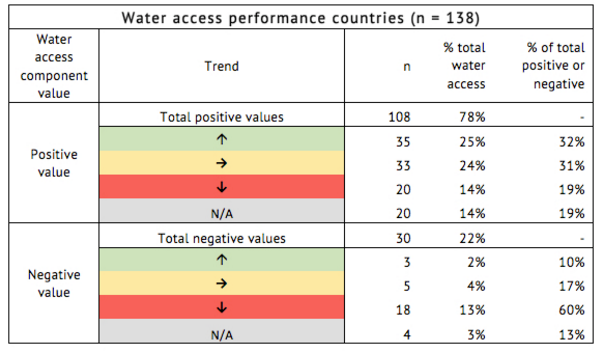The WASH Performance Index Report - Water Access
Contents
[hide]Country performance in improving water access
- Country rates of change (progression or regression, percent per year) in access to water were compared to the performance frontier (best-in-class performance) to generate a country value for performance in improving water access.
- Despite persistently being the region with the lowest water coverage in the world, water access performance among countries in Sub-Saharan Africa varies widely, with both top and bottom performers in the region.
- Country performance in improving water access is positively associated with the South Asia region, suggesting countries from this region have been performing better as compared to other regions.
- Top performing countries in improving water access are El Salvador, Mali, Tajikistan, Nepal, Liberia, Nigeria, Sri Lanka, Lao PDR, Maldives, and Thailand.
- Bottom performing countries are Namibia, Mauritania, the Dominican Republic, Costa Rica, North Korea, Belarus, Ghana, Jordan, the Solomon Islands, and Colombia.
Country rates of change (progression or regression, percent per year) in access to water were compared to the performance frontier (best-in-class performance) to generate a country value for performance in improving water access. Values for water access performance were calculated for 138 countries. Figure 3 summarizes the values.

In contrast, Figure 4 shows water coverage. Despite persistently being the region with the lowest water coverage in the world, water access performance among countries in Sub-Saharan Africa varies widely, with both top and bottom performers. Identifying characteristics of top performing countries and learning from them may enable more rapid progress among countries. South East Asia has higher performance despite low coverage, while South America has higher coverage but lower performance.

Figure 5 shows all the rates of change used in defining the performance frontier for water access. Points defining the performance frontier were: Ethiopia (1998), Cambodia (1998), Malawi (1997), Cambodia (2009), Namibia (2001), El Salvador (2007), Armenia (2005), Armenia (2008), and Belarus (2009). Figure 6 shows the latest rates of change from each country.


Top and bottom performing countries
Top performing countries for water access performance are El Salvador, Mali, Tajikistan, Nepal, Liberia, Nigeria, Sri Lanka, Lao PDR, Maldives, and Thailand. Bottom performing countries are Namibia, Mauritania, the Dominican Republic, Costa Rica, North Korea, Belarus, Ghana, Jordan, the Solomon Islands, and Colombia.
Mali, a top performing country, has rapidly increased coverage. In 1987, coverage was 26%, passing 40% in the early 2000s and reaching 72% in 2010. Another example is Tajikistan. Despite stagnant coverage from 1999 (61%) to 2003 (62%), Tajikistan has increased access to improved water sources from 62% in 2003 to 77% in 2012.
In contrast, the Dominican Republic has experienced slippage in coverage. From 1996 to 2000, coverage was near 90%. Coverage fell to 85% in 2003 and 79% in both 2007 and 2010. Namibia is experiencing stagnation. While Namibia experienced a rapid increase in access from the early 1990s to the mid-2000s, with coverage increasing from 65% to nearly 90%, in more recent years slipped to 86% in 2004 and 2007 and further down to 82% in 2010.
Among the most populated countries in the world, Nigeria, Pakistan and Mexico were among top performers while India, Bangladesh, and Indonesia were among the bottom performers.
Alphabetical lists of countries with values for all components and trends are available in the Annex.
Correlations
Country performance in improving water access is significantly and positively associated with the South Asia region, suggesting countries from this region have been performing better as compared to other regions. Country performance in improving water access is negatively associated with GDP per capita, though the regression model suggests that changes in GDP are associated with little change in performance.
There were no other significant associations among country characteristics examined.
No governance indicators were associated with water access performance.
Trends in performance
Table 2 shows the trend in country values for water access performance. The trends suggest countries with a positive value vary in whether they improved over time, with a roughly even number of countries improving, unchanged, or deteriorating. Conversely, the majority (60%) of countries with a negative 2015 value deteriorated over time. This suggests, for water access performance, that deterioration is a long-term phenomenon – meaning that countries with negative values continue to deteriorate over time.

Acknowledgements
- The WASH Performance Index Report, The Water Institute - University of North Carolina.

